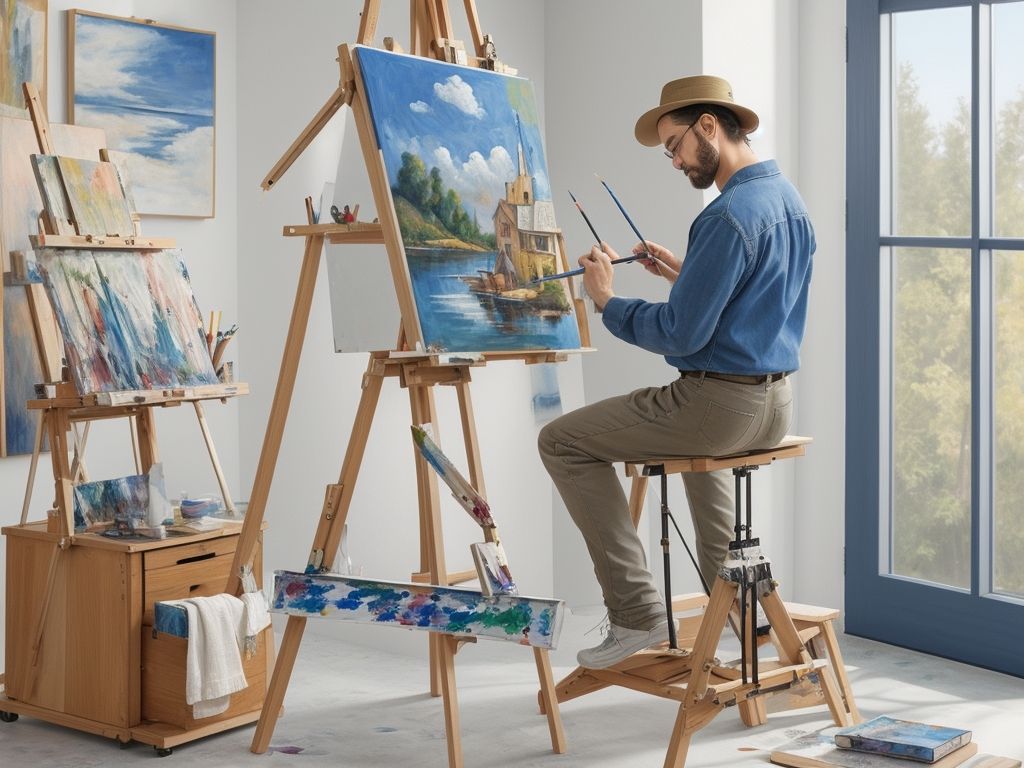How To Choose The Best Studio Easels
Deciding on the best studio easel can be tough, but with the correct direction it’s an enjoyable and rewarding experience. Let’s explore the world of studio easels and find out the essential factors to think about when making this important decision.
When selecting, first take into account your individual artistic needs. Every artist has different wants and needs, such as the size of canvases they use or the flexibility they demand from their easel. Points to look into include height adjustment mechanisms, stability, and portability.
On top of that, being familiar with the various types of studio easels is key to making an educated decision. H-frame easels provide great stability and support for large canvases, while A-frame or tripod easels offer versatility and portability. There are also special easels designed for certain mediums like watercolor or pastels.
To add to the range of choices, there are different materials used in making studio easels. Wood is a preferred choice because of its strength and good looks. Metal easels on the other hand offer a lightweight solution while keeping stability. Investigating these material options will help artists select an easel that fits their artistic vision.
Now let’s take a look at a real story which explains why selecting the best studio easel is so important for an artist’s journey. Emily, a painter from New York City, had been using a worn-out easel for years until she decided it was time for an upgrade. After thorough research and testing different models at her local art store, she finally found the ideal one – an adjustable H-frame wooden easel that provided stability for her large-scale paintings. The transformation in her artwork was amazing as she now had a reliable base to express her creative abilities.
Importance of choosing the right studio easel
Choosing the right studio easel is very important for an artist. Here are the reasons why:
- Comfort & Ergonomics: Easels that fit an artist’s needs can help to prevent neck and back strain.
- Stability & Durability: Sturdy easels keep paintings secure during the creative process.
- Adjustability & Flexibility: Adjustable easels let artists work in their preferred way.
- Storage & Organization: Easels with storage make it easier to keep art supplies organized.
- Aesthetic Appeal: A nice easel can inspire an artist by creating a beautiful environment.
When picking an easel, consider the size of artworks, the available workspace, budget, and preferences. Try different models before buying. Read reviews to find out the pros & cons of each. To maximize comfort, use adjustable stools or cushioned mats.
Factors to consider when choosing a studio easel
Choosing a studio easel can be tough. Several elements can affect your creative experience. Here are 5 key points to think about when selecting one:
- Stability: Get an easel that is strong and steady. Make sure it can hold the size and weight of your canvas or board.
- Adjustability: Pick one that offers various angles and heights. This lets you paint comfortably, whether you sit or stand.
- Portability: See how easy it would be to move around. This is important if you plan to work in different spots or go to art classes. A lightweight and foldable design makes transportation easy.
- Storage: Some easels come with built-in compartments or trays for art supplies like brushes, paints, and palettes. This can save studio space.
- Durability: Invest in a high-quality easel. Choose materials that won’t wear down easily.
In addition, look for features like locking mechanisms. Also check the assembly process – make sure it’s not too hard.
Centuries ago, famous artists like Leonardo da Vinci and Vincent van Gogh had their own portable wooden easels. They used them to paint outdoors and capture landscapes. These artists knew the importance of finding the right easel.
Think about stability, adjustability, portability, storage space, and durability when choosing your perfect studio easel. Any unique details that fit your preferences are also worth considering. Great artists can remind us of the significance of using the right tools for our creative journeys.
Different types of studio easels
Studio easels are must-haves for artists to make their works of art. Different types of studio easels have unique features and benefits. Knowing the options can help artists decide which is best for them.
Let’s look at some popular types:
- H-Frame Easels: Sturdy and stable. Adjustable so artists can work at different angles.
- A-Frame Easels: Lightweight and portable. Great for artists who often travel or work in small spaces.
- Single Mast Easels: Versatile and compact. Suitable for small and medium-sized artworks.
- Giant Easels: For large canvases. Perfect for those ambitious projects.
When selecting a studio easel, other things to think about include:
- Stability – having a strong foundation helps artists be precise and prevents movements.
- Adjustability – adjust height, angle and canvas size to be comfortable and have freedom.
- Storage – foldable or collapsible models make transportation and storage easier.
By considering these, artists can make their studio easel perfect for them and create extraordinary artworks with ease.
Pros and cons of each type
Weighing the pros and cons of each type of studio easel is important when deciding which one is best for your artistic needs. To make this easier, we have made a table below to show the advantages and disadvantages of every type.
Pros and Cons of Each Type:
| Type | Pros | Cons |
|---|---|---|
| H-frame Easel | Provides stability for large canvases. | Bulky and takes up more space. |
| A-frame Easel | Versatile and can be used for different painting styles. | May not provide enough stability for bigger canvases. |
| Single-mast Easel | Good for smaller studios. | Lacks features such as tilt adjustment. |
It’s worth noting that each type has its individual details which are different from the others. An H-frame easel provides great stability, making it ideal for larger canvases. An A-frame easel gives versatility, allowing artists to try various painting styles.
Easels have been used by artists for centuries as a practical tool for their artwork. Over time, easels have been designed and developed to cater to different artistic needs. Nowadays, artists can choose from a range of options according to their preferences and studio requirements.
Recommendations for different art mediums
When it comes to art, the right studio easel can make all the difference. Here are some recommendations:
| Medium | Easel Type | Recommended Features |
|---|---|---|
| Oil | H-Frame | Stable & sturdy. Adjustable height & tilt angle. |
| Watercolor | Watercolor | Lightweight & portable. Adjustable angles for techniques. |
| Acrylic | A-Frame | Versatile. Adjustable mast. Suitable for small & large canvases. |
| Pastel | Convertible | Tiltable top. Storage drawers for supplies. |
Oil painters should get an H-frame easel. It’s stable & sturdy, with adjustable height & tilt angle.
Watercolor easels are lightweight & portable. They often have adjustable angles for techniques.
For acrylics, an A-frame is suitable. It has an adjustable mast & can hold small & large canvases.
Pastel artists may prefer a convertible easel. It has a tiltable top & storage drawers for supplies.
Few people know that the right easel can boost an artist’s productivity. Art experts say investing in a high-quality easel can help a creative process.
Tips for maintaining and caring for a studio easel
Caring for a studio easel is super important. Here’s how to ensure yours stays in top condition:
- Clean it regularly – get rid of dust, dirt and paint residue with a soft cloth or brush. Pay attention to all the nooks and crannies.
- Tighten any loose screws – so your easel doesn’t wobble while you work.
- Store it properly – don’t put heavy objects on top of it or lean it against walls where it may get damaged.
- Lubricate the parts that move – to keep everything running smoothly and prevent rust.
- Protect from sunlight – direct sunlight can fade and warp the wood or metal, so keep it away from windows or block harsh sunlight with curtains or blinds.
Plus, remember these details too:
- Avoid extreme temperatures – too hot or cold can affect its stability and warp the wood.
To keep your studio easel in great shape:
- Set up a regular maintenance routine – with cleaning and inspecting.
- Invest in a protective cover – to stop dust, moisture and spills.
- Follow manufacturer’s instructions – they may have specific recommendations for your easel model.
Caring for your studio easel is an investment in your art. Keep it clean, stored properly, lubricated, and out of sunlight – and you’ll enjoy using it for years to come!
Conclusion
‘How To Choose The Best Studio Easels’ has offered some great advice. Let’s review the main points:
- Size and weight: Pick something to fit your studio and support your canvas.
- Stability and durability: Solid materials that can handle your mediums.
- Adjustability: Change the height, tilt, and angle as you need.
- Storage and portability: Collapsible or portable if you like to move it around.
- Your art style: Know what features you need for your creative process.
Also consider the overall look of the easel. It might add to your inspiration.
For extra help, read reviews and ask other artists. Their knowledge can guide you to the ideal easel for your art.
Frequently Asked Questions
1. What factors should I consider when choosing a studio easel?
When choosing a studio easel, it’s important to consider factors such as the size and weight of the easel, its stability, the materials it is made of, the type of art you create, and your budget.
2. What are the different types of studio easels available?
There are various types of studio easels available, including tripod easels, H-frame easels, convertible easels, and horizontal easels. Each type has its own advantages and is suitable for different artistic styles and preferences.
3. How do I determine the appropriate size of a studio easel?
The size of the studio easel you choose should depend on the size of your artwork. It’s important to ensure that the easel can securely hold your largest canvas size without toppling over or becoming unstable.
4. What materials are commonly used in studio easels?
Studio easels are usually made from wood, metal, or a combination of both. Wooden easels are sturdy and durable, while metal easels are lightweight and often more portable. The choice of material depends on personal preference and requirements.
5. Are there any specific features I should look for in a studio easel?
Some features to consider when choosing a studio easel include adjustable height and angle, storage options for art supplies, a secure locking mechanism, and the ability to hold different canvas sizes. These features can enhance your painting experience and ensure convenience.
6. How much should I budget for a high-quality studio easel?
The cost of a studio easel can vary depending on its size, materials, and additional features. While it’s possible to find affordable options, investing in a high-quality easel is recommended as it will be more durable and provide better stability in the long run. A budget of $100-$500 is a reasonable range for a quality studio easel.
- How To Choose The Best Lap Desk For Laptop And Writing - 15 October 2023
- How To Choose The Best Projection Screen With Foldable Stands - 14 October 2023
- How To Choose The Best Antifungal Pill For Dogs - 13 October 2023

